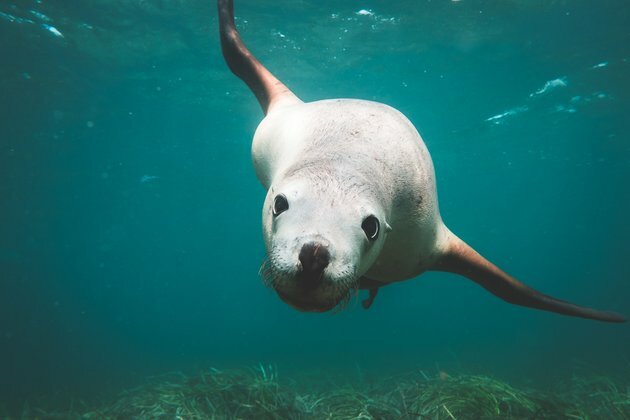Sea lion whiskers can move like human fingertips: here's how we found out
The Conversation
25 Nov 2021, 20:10 GMT+10

Humans have amazing fingertips. They are sensitive and can be moved over objects to feel its softness, texture, size and shape. These movements are both complex, and "task-specific". This means that you adopt different movements depending on what you want to feel about an object. We squeeze or push objects to judge softness, and feel around the edges of objects to judge size and shape. And if you wanted to feel the texture of an object, you would sweep your fingertips over the surface.
Being able to adopt different movement strategies shows that we can precisely control our fingertip movements and draw on our past experiences in order to pay attention to important aspects of an object - the edges of shapes and the surfaces of textures, for example. This means that we have a high level of control over our sensory perception, and we call this active touch sensing.
Touch sensing in mammals
Most mammals do not have as moveable or sensitive fingertips as humans. Instead they have whiskers, which are touch sensitive hairs on their faces, and used to guide locomotion, foraging for food and to explore objects.
Neuroscientists have been studying whiskers for decades, especially in laboratory rats and mice, trying to understand how signals from the whiskers are processed in the brain. But only now are we realising that whiskers are also moved with amazing strategies, just like our fingers.
Rats, mice, and some other mammals, can move their whiskers in a to-and-fro scanning motion called "whisking". Whisking is one of the fastest movements that mammals can make, occurring up to 25 times per second in mice.
When rats and mice contact objects they also adopt other whisker movements. These include bunching up their whiskers to make more of them touch a surface, making light touches to enable clearer signals against a surface, and slowing down whisker movements so they contact the surface for longer.
But no one knew whether animals could adapt their whisker movements specifically for different tasks.
Such "task-specific" movements would be an exciting discovery as it would indicate a precise level of control over their sensors and perception.
Choosing a candidate species
The first step in answering this important question was to choose a likely candidate species for our investigation.
Pinnipeds, including seals, sea lions and walruses, have whiskers that are particularly thick and long, making them easier to measure than those of smaller mammals such as mice.
They also have some of the most sensitive whiskers of any mammal - they can detect textures and shapes to the same sensitivity as human fingertips, even in cold water when our fingers would go numb.
They are also moveable. We have previously found that California sea lions make the largest and most controlled movements with their whiskers, when compared to harbour seals and Pacific walruses.
Those factors, plus their ability to perform object-discrimination tasks - where they could distinguish between objects based on size and shape - made California sea lions the ideal subject for our investigation on task-specific whisker movements.
Our work with Lo
For our study we used a sea lion, Lo, for the full complement of experiments. Having only one individual is common in marine mammal studies, but it does put pressure on the investigators to collect good quality and highly quantitative data from that one individual.
Lo was trained to complete a texture-discrimination task using only her whiskers.
She had to find a medium-textured, fish-shaped object among other distractor fish. She also completed a size-discrimination task of finding a medium-sized fish amongst other distractors, and a visual task of finding a grey fish amongst other coloured distractors (sea lions use very small whisker movements in visual tasks).
Lo was filmed doing the tasks thousands of times, and her whisker and head positions were tracked in the video footage.
Looking at the data and the video footage it was clear that Lo made task-specific movements with her whiskers. She made sweeping movements over textured surfaces, and felt around the edges of the different sized shapes. These specific movement strategies are also used by humans with our fingertips.
The ability to switch whisker exploration strategies between tactile tasks enabled Lo to complete the tasks efficiently. Lo found the correct fish in almost all trials and made decisions quickly, in under half a second. Video footage of the other sea lions also showed them employing the same strategies, so we think that this might be common among California sea lions in general.
And now other animals
Seeing the same movement strategies conserved from sea lion whisker movements to human fingertip movements showcases how important these strategies are for improving touch signals across different tasks.
It is likely that other species of Pinniped will be able to make task-specific whisker movements, since they also have sensitive, moveable whiskers. We are investigating this now, along with other species of carnivores, such as otters.
This is the first time that task-specific whisker touch sensing has been documented. It demonstrates that studying whiskers can give us important insights into animal movement control, as well as their perception and cognition.
Read more: How we found a special maths equation hidden in rat whiskers
Author: Robyn Grant - Senior Lecturer in Comparative Physiology & Behaviour, Manchester Metropolitan University 
 Share
Share
 Tweet
Tweet
 Share
Share
 Flip
Flip
 Email
Email
Watch latest videos
Subscribe and Follow
Get a daily dose of Bristol Star news through our daily email, its complimentary and keeps you fully up to date with world and business news as well.
News RELEASES
Publish news of your business, community or sports group, personnel appointments, major event and more by submitting a news release to Bristol Star.
More InformationUnited Kingdom
SectionShell rejects claim of early merger talks with BP
LONDON, U.K.: British oil giant Shell has denied reports that it is in talks to acquire rival oil company BP. The Wall Street Journal...
China: Building a 'Patriots Only' Hong Kong
(New York) - China's government has erased Hong Kong's freedoms since imposing the draconian National Security Law on June 30, 2020,...
China boosting purchases of Russian metals Bloomberg
Aluminum, copper and nickel shipments have surged this year, according to trade data Beijing has increased purchases of Russian metals...
FIFA Club WC: Last two QF spots up for grabs as Real Madrid, Dortmund among teams in action
New Delhi [India], July 1 (ANI): The last two spots for the quarterfinals of the FIFA Club World Cup will be sealed by either Spanish...
"Everyone was sort of very tired from week": Ben Stokes reflects on England's fitness ahead of second test against India
Birmingham [UK] July 1 (ANI): Heading into the second test against India at Edgbaston, Birmingham, England skipper Ben Stokes spoke...
Why is Islamophobia so hard to define?
The UK government wants a new definition of Islamophobia and has created a working group of politicians, academics and independent...
International
SectionNative leaders, activists oppose detention site on Florida wetlands
EVERGLADES, Florida: Over the weekend, a diverse coalition of environmental activists, Native American leaders, and residents gathered...
Beijing crowds cheer AI-powered robots over real soccer players
BEIJING, China: China's national soccer team may struggle to stir excitement, but its humanoid robots are drawing cheers — and not...
COVID-19 source still unknown, says WHO panel
]LONDON, U.K.: A World Health Organization (WHO) expert group investigating the origins of the COVID-19 pandemic released its final...
Fox faces $787 million lawsuit from Newsom over Trump phone call
DOVER, Delaware: California Governor Gavin Newsom has taken legal aim at Fox News, accusing the network of deliberately distorting...
DeepSeek faces app store ban in Germany over data transfer fears
FRANKFURT, Germany: Germany has become the latest country to challenge Chinese AI firm DeepSeek over its data practices, as pressure...
Canadian option offered to Harvard graduates facing US visa issues
TORONTO, Canada: Harvard University and the University of Toronto have created a backup plan to ensure Harvard graduate students continue...













